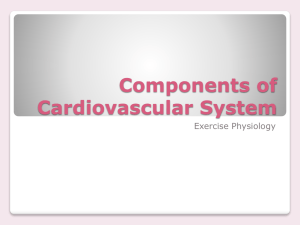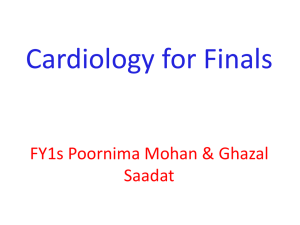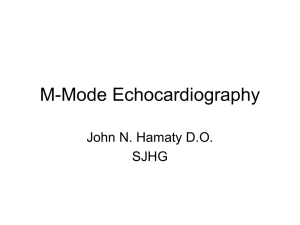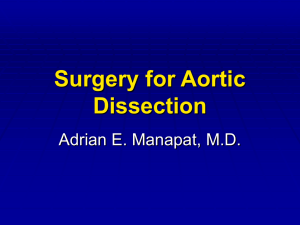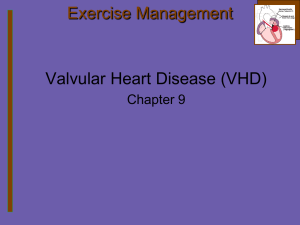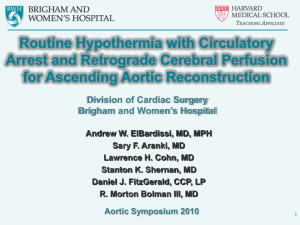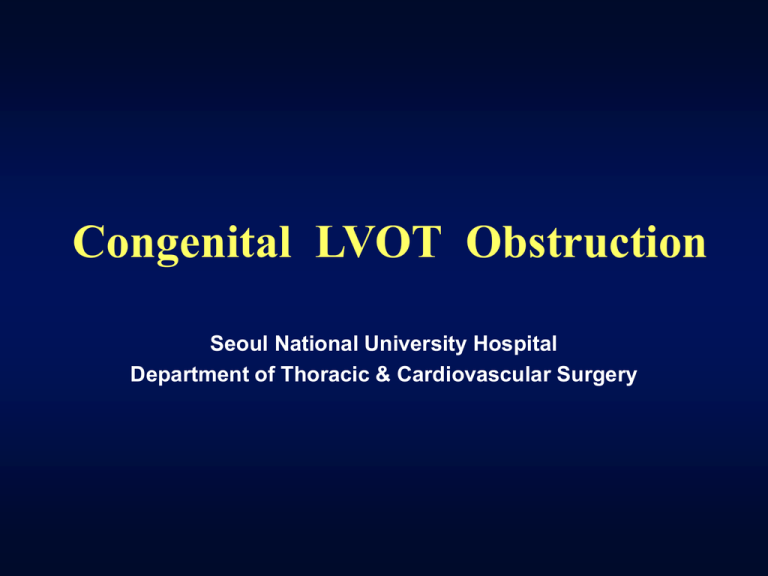
Congenital LVOT Obstruction
Seoul National University Hospital
Department of Thoracic & Cardiovascular Surgery
Congenital LVOT Obstruction
Types of obstruction
1.
2.
3.
4.
5.
Supravalvular aortic stenosis
Valvular aortic stenosis
Subvalvular aortic stenosis
Intraventricular obstruction
Hypoplastic left heart syndrome
Left Ventricular Outflow Tract
Congenital malformations
• Obstruction
* Supravalvular
* Valvular
* Subvalvular
* Intraventricular obstruction
- Occurs in combination with other cardiac lesions
( Interruption, COA, MV apparatus anomalies,
left ventricular hypoplasia )
• Regurgitation
* Annular aortic root dilatation
* Prolapse of valve leaflets
* Degenerative abnormality
* Rupture of aneurysm of sinus of Valsalva
LVOT Obstruction
Pathophysiology
Left ventricular outflow tract
obstruction(LVOTO ) leads to left
ventricular hypertrophy, ischemia,
and ventricular dysfunction.
The obstruction is at the valvar ,
subvavar, or supravalvar level.
Congenital Aortic Valve Diseases
Manifestation
1 Incidence
* 2 - 6% of CHD ( about 5%)
* AS : common,
M:F=4:1
* AR : less common, no sex predilection
2 Etiology
1) AS : not known or no evidence
# probably genetic aberration in IHS,
and supravalvular stenosis
# fetal aortic valve endocarditis
2) AR : caused by any one of several disease (rheumatic
fever, endocarditis, Marfan syndrome, Ehlers Danlos syndrome, connective tissue disorders)
Congenital Aortic Valve Diseases
Reparative procedures
1 Aortic stenosis
* Not curative, but palliative
* High mortality in neonate
* Reasonable mortality in infant and children
* Residual stenosis & induced aortic regurgitation
* Overall 10-year survival : 80 - 90%
* 10-year reoperation-free survival : 50 - 60%
2 Aortic regurgitation
* Medical treatment if possible
* Valvoplasty for prolapsing cusp
* Aortic valve replacement
Congenital Aortic Stenosis
Definition
• A cardiac anomaly in which narrowing at
valvar, subvalvar, supravalvar, or combined
levels results in a systolic pressure gradient
between the inflow portion of left ventricle &
aorta beyond obstruction.
• Classification refers to the predominant area of
obstruction in the left ventricular outflow tract,
inevitably, these groups sometimes overlap
because of the complexity of pathologic changes
LV Outflow Tract
Structures
Aortic Stenosis
Types
Aortic Outflow Obstruction
Clinical features
1 Infantile
1) Usually appears within the 1st. month of life
2) Presentation in later infancy according to the severity and growth
3) Untreated mortality ; 23% in the 1st. year
2 Childhood
1) Progressive with growth, rare in early childhood
2) If left ventricular failure develops, rapidly deteriorate
3) Sudden death : 1-19%, but rare in low pressure gradient
* Consequence of low aortic pressure (coronary insufficiency)
* Arrhythmia
* Frequent when resting pressure gradient more than 50mmHg
4) Untreated mortality
* 60% at 40 years
* Mean age of death : 35 years
Aortic Outflow Obstruction
Operation
1 Indications
1) Critical AS in neonate ; urgent
2) Infant and children
* Pressure gradient over 70mmHg
* Sx. of angina, syncope, exercise intolerance, LVH, with pr. gradient
over 50mmHg and valve area less than 0.5 square cm/BSA
* Pressure gradient over 40mmHg in subvalvular lesion
2 Methods
1) Valvotomy
* Open & closed technique (hypothermia)
* Balloon valvotomy
2) Resection of subvalvular tissue & myocardium
3) Aortoplasty of supravalvular stenosis
4) Aortoventriculoplasty in tunnel stenosis
5) Valve replacement
Congenital Valvar Aortic Stenosis
Definition
An obstruction at valve level caused by imperfect
cusp development with leaflet thickening and
fusion
• History
Marquis, Logan : Surgical treatment by dilator in 1955
Swan, Lewis
: Open valvotomy in 1956
Spencer
: Valvotomy through OHS in 1958
Congenital Valvar Aortic Stenosis
Manifestation
1 Etiology : unknown
* Malabsorption of conal element ( leaflet dysplasia as in PS)
* Histologic disorganization of aortic media and dysplasia in left
ventricular septum (Somerville) & hypoplasia of annulus rarely
2 Incidence : 3~6% of all CHD, 60 - 70% of AS
3 Anatomy
* Hypoplasia of annulus : rare
* Abnormally formed valve leaflets : majority
Bicuspid ; 70% (left and right)
Unicuspid
Thick and dysplastic valve
- Commonly associated with COA, MV abnormalities, sub or
supravalvar stenosis, hypoplastic ventricle -
Congenital Valvar Aortic Stenosis
Morphology
• Aortic valve
Bicuspid in 70%
Tricuspid in 30%
Unicuspid rarely
Varying degree of thickened dysplastic leaflets
• Left ventricle
Concentric hypertrophied, tiny cavity
Endocardial fibroelastosis in extreme case with dilation
• Coexisting cardiac anomalies
Fibrous subvalvar, supravalvar stenosis
COA, varying degree of HLHS
PDA, VSD, PA
Congenital Valvar Aortic Stenosis
Bicuspid aortic valve
Congenital Valvar Aortic Stenosis
Bicuspid aortic valve
Congenital Valvar Aortic Stenosis
Patterns of presentation
• Presentation in infancy
Almost always severe, rapidly progressive CHF
Untreated mortality : 23% in 1st year
• Presentation in childhood
Beyond 1 year of age, heart failure is rare.
Sudden death varies between 1-19%.
Develop progressive ultimately important stenosis
Bacterial endocarditis
Bicuspid Aortic Valve
Natural history
1.
2.
3.
4.
Incidence approximately 1~2% of population
Rarely becomes stenotic or incompetence in early life
Sclerosis begins in the second decade of life.
Aortic stenosis develops in 72% by the fifth & sixth
decades of life.
5. Endocarditis occurs in 10% of these patients.
6. Incompetence independent of endocarditis occurs
in 5 - 39% of these patients.
7. Bicuspid aortic valve have been noted in 25-40% with
supravalvar & 9-20% with subvalvular aortic stenosis.
Bicuspid Aortic Valve
Development
• Bicuspid aortic valve, the most common congenital
cardiac malformation, is caused by fusion of valve
cushions at the onset of valvulogenesis.
• At the beginning of valvulogenesis, a population of cells
called neural crest cells migrate away from the neural
fold and spread throughout the embryo.
• These cells seem to play a crucial role in normal
development of cardiac outflow tract &semilunar valves
• The basic helix-loop-helix transcription factor dHAND is
essential for survival of cells in neural crest–derived
ventricular structures and aortic arch arteries
Congenital Valvar Aortic Stenosis
Techniques of operation
• Percutaneous balloon valvotomy
• Valvotomy in neonates & critically ill infants
• Valvotomy in older infants, children & adults
• Aortic valve replacement
Congenital Valvar Aortic Stenosis
Open techniques
• Precise commissurotomy
• Shaving of thickened leaflets
• Excision of obstructive myxomatous
nodularities
• Mobilization of leaflets
• These procedures can be performed with
a low surgical risk & 85% freedom from
reoperation at 5 years
Bicuspid Valvar Aortic Stenosis
Tricuspidization with cusp extension
• Criteria for TCE included an aortic orifice that is equal
to or greater than normal (normalized for body surface
area) after commissurotomy and division of the raphe,
adequate mobility of all cusps at the hinge point,
absence of cusp dysplasia involving the belly of the
cusps, commissures that are free of calcification or
exuberant fibrosis, and normal location of the coronary
ostia.
• When these criteria were met, TCE was the procedure
of choice.
Bicuspid Aortic Stenosis
Tricuspidization with cusp extension
The height of coapting pericardial patches is increased toward the neocommissure to
compensate for the lack of a true interleaflet triangle and to elevate the hinge point of the
leaflets. Each new commissure is constructed by suturing the apposing short edges of each
patch together and to the aortic wall, creating an elongated vertical axis of the native
commissures
Critical Aortic Stenosis
Optimal management
• In fact, if percutaneous balloon valvotomy usually
causes rupture along lines of least resistance, either
along underdeveloped commissures or into leaflet tissue.
• Surgical valvotomy allows direct inspection of the valve,
more fashioning of commissurotomies, and
debridement of any excess tissue on the leaflets.
• When small aortic annulus and depressed ventricular
function are associated, surgical or therapeutic options
other than surgical commissurotomy could be
considered, including balloon dilation as a bridge to
surgery, neonatal Ross operation, Norwood operation,
or possibly neonatal double switch operation.
Bicuspid Aortic Valve
Operative technique
Aortic Stenosis
Aortic valve bypass
• Aortic valve bypass for high-risk patient with aortic stenosis
Aortic Stenosis
Aortic valve bypass surgery
• Ideal candidates for this type of approach could include
patients with ascending aortic calcification, patients
who require complex reoperations, and patients with a
small annulus
• Potential problems include pseudoaneurysm as
described in their article, bleeding due to lack of control
of the left ventricular (LV) apex, difficulty with the
aortic anastomosis in the descending aorta due to
extensive calcification of the descending aorta, kinking
of the conduit, and theoretical dislodgement of an LV
apical thrombus and nonphysiologic flow from the LV
Valvar Aortic Stenosis
Results of operation
1. Survival
Early deaths
Time-related survival
2. Modes of death
Acute cardiac failure
Sudden death, residual
stenosis, incompetence
3. Incremental risk factors for
premature death
1) Left-sided cardiac anomalies
2) Preoperative functional class
3) Type of valvar stenosis
4) Young age
4. Functional status
5. EKG changes
6. LV structure and function
7. Residual or restenosis
8. Aortic valve incompetence
9. Bacterial endocarditis
10. Reintervention
Valvar Aortic Stenosis
Indications for operation
1. Original valvotomy
1) Neonates and young infants
Treatment on emergency basis
2) Older infants and children
EKG shows severe hypertrophy
Pressure gradient more than 50mmHg
Symptoms of angina or syncope
2. Reoperation
Symptoms develop with moderate stenosis
Congenital Aortic Stenosis
Biventricular repair
Contraindications
• Small left ventricle
< 20ml / BSA, Inlet length < 25mm
• Narrow aortic valve ring
< 5mm
• Small mitral valve orifice
< 9mm
• Extensive fibroelastosis
Congenital Aortic Stenosis
Norwood vs aortic valvotomy
1. Mitral valve area less than 4.75 cm 2 /m2
2. LV inflow dimension less than 25 mm
3. Small LV by a ratio between apex-to-base
dimension of LV & that of RV of less than 0.8
4. Left ventricular transverse cavity & aortic
annular dimension less than 6 mm
Subvalvar Aortic Stenosis
Introduction
1. Definition
An obstruction beneath the aortic valve due either to
a short, localized fibrous or fibromuscular ridge or
a long (diffuse) fibrous tunnel.
Subvalvar aortic stenosis may also be a part of other
cardiac anomalies.
2. History
Chevers
Brock
Spencer
Konno,Rastan
: 1st description in 1842
: Transventricular dilation in 1956
: 1st repair using CPB in 1960
: Aortoventriculoplasty in 1975
Subvalvular Aortic Stenosis
Charcteristics
1 Etiology : unknown but congenital and postnatal
(turbulence phenomenon to abnormal
contractility caused by focal area of
dysplastic myocardium)
2 Incidence : 10 -20% of AS (0.25 for every 1000 live births)
3 Anatomy
* Discrete ring of fibrous tissue
* Persistent conus muscle in subaortic area
* Tunnel syndrome( 20% of SubAS)
Subvalvar Aortic Stenosis
Morphology
•
Aortic valve
Usually normal
Trivial or mild AR in 2/3 due to leaflet thickening, or ,
effect of eddy current.
•
Left ventricle
Usually concentrically hypertrophied
Subendocardial ischemia and fibrosis
•
Coexisting cardiac anomalies
Isolated in 1/2-2/3
VSD, IAA, PDA, COA, PS, TOF, ASD, AP window
•
Other type of discrete subvalvar stenosis
Mitral valve anomalies : accessory tissue or leaflet malposition
Localized muscular obstructions : related to malalignment
Subvalvar Aortic Stenosis
Patterns of type
1. Localized type
Fibrous or fibromuscular
Localized or circular
Variable degree of septal hypertrophy
2. Tunnel type
1/5 of subvalvar aortic stenosis
Circumferential irregular zone of fibrosis
Varying degree of obstruction
Subvalvar Aortic Stenosis
Fibromuscular stenosis
Subvalvar Aortic Stenosis
Subaortic tunnel stenosis
Subvalvar Aortic Stenosis
Supramitral ring
Subvalvar Aortic Stenosis
Clinical features & diagnosis
1. Incidence
10-20% of AS
2. Symptoms and signs
25% requiring operation are asymptomatic.
Systolic murmur, diastolic murmur in 65%
Pulse is slow rising.
3. Chest X-Ray, EKG
4. Echocardiography
5. Cardiac catheterization and cineangiography
Subvalvar Aortic Stenosis
Natural history
•
10-30% of congenital LVOT obstruction
•
Rarely important obstruction in infancy
•
Evident and progressive with age
probably more rapidly than valvar stenosis
•
Aortic incompetence is a progressive lesion
secondary to leaflet thickening.
Subaortic Stenosis
Development & progression
1. Acquired nature of this lesion
2. Rarely in neonate and young children
3. Rheologic theory
Morphologic abnormalities in left ventricular - aorta
junction, such as steeper aortoseptal angle results
in altered septal shear stress and triggers a genetic
predisposition leading to cell proliferation and
structure in LVOT.
4. Uncertainty about rapidity of progression
Subaortic Stenosis
Development
1. Subaortic constraint at the entry of the tunnel and the sinus
shape of the letter lead to turbulent flow, resulting in muscle
hypertrophy, or deposition of fibrous material.
2. Growth of heart without concomitant increase in the size of
VSD, and tunnel
3. Excessive decrease of LV diameter and the increase in wall
thickness after biventricular repair, causes the diminution of
the VSD orifice and the augmentation of the malalignment.
4. Other possible causes are kinking of the baffle, shrinkage of
the baffle with time
5. Chronic flow disturbance caused by a somewhat narrowed
and elongated LVOT
Discrete Fibrous Ring
Histology
In the subaortic region, the progression of discrete
fibrous obstruction results in a gross appearance &
histology with similarity to vascular lesions by Rodbard.
The typical fibrous ring has distinct five layers.
• Endothelial layer
• Mucopolysaccharide-rich subendothelial layer
• Fibroelastic layer
• Smooth muscle layer
• Central fibrous layer
Subaortic Stenosis
Effect of localized stenosis
A is normal aorta is depicted with the arrow indicating
the direction of flow in the longitudinal view.
B, C, and D show the progressive nature of the changes in the aorta.
Subaortic Stenosis
LVOT geometry & shear stress
( Aortoseptal angle )
Role of shear stress in the progression of subaortic stenosis
Discrete Subaortic Stenosis
Etiology
• Morphologic abnormalities & subsequent rheologic effects, an exuberant
response to local injury, and further exacerbation of the process through
a positive feedback loop
Subaortic Stenosis
Anatomic abnormalities
• Increased steepness of aortoseptal angle
Malalignment of ventricular septum
Prominent ventricular band
Protrusion of muscular septum
• Increased aorto-mitral separation
• Small aortic annulus
Subaortic Stenosis
Extended septoplasty
Prior Closure of VSD during Repair of DORV
Subaortic Septal Plane
Anatomy
Relationship between the plane of the outlet septum and the plane of the septal crest
in the normal heart (A), and atrioventricular septal defect (B),
a VSD has been created and a patch applied to augment the diameter of the LVOT.
LVOT & RVOT
Geometry
The scheme of the left & right ventricular outflow tract
showing the normal anatomy (A),
subaortic myectomy (B), a modified Konno procedure (C).
Muscular Subaortic Obstruction
Clinical characteristics
1 Etiology
* Genetic basis
* Secondary hypertrophy
. Idiopathic hypertrophic subaortic stenosis
. Hypertrophic obstructive cardiomyopathy
. Asymmetrical septal hypertrophy
2 Incidence : rare in infant & childhood
3 Pathology
* Microscopic finding :
Irregular arrangement of sarcomere and myofibrils
( possibility of hamartoma, and of inappropriate
development of primitive myocardial cell)
Subaortic Stenosis
Techniques of operation
1. Resection of localized subvalvar aortic stenosis
2. Repair of tunnel stenosis by aortoventriculoplasty
3. Aortoventriculoplasty by mini root replacement
Autograft
Homograft
4. Modified Konno operation.
Subaortic Stenosis
Principles of surgical treatment
• Surgery must be aimed at the removal of all the
structures causing flow turbulence in the LVOT
in order to reduce the incidence of these
complications
• Aggressive surgical approaches have been
proposed other than "simple" excision of the
fibrous ring, including early operation before
appearance of severe left ventricle hypertrophy,
extended and circumferential myectomy, and
mobilization of the left & right fibrous trigones.
Subaortic Stenosis
LVOT Anomalies
• The association between discrete subaortic stenosis &
other left ventricular outflow tract anomalies such as
• Anomalous mitral valve insertion
• Accessory mitral valve tissue
• Abnormal mitral papillary muscle
• Anomalous muscular bands within the LVOT
• Posterior displacement of infundibular septum without
VSD
Hypertrophic Cardiomyopathy
Morphology
• Accessory papillary muscle arising from the anterior free wall
with chordal attachments to the mitral leaflet and free wall.
• Anomalous chordae tendineae arising from a papillary muscle
and inserting into the septum.
Hypertrophic Cardiomyopathy
Extended septal myectomy
• Ventricular septal myectomy for hypertrophic obstructive cardiomyopathy
• Extended left ventricular septal myectomy for anomalous papillary muscle
with direct insertion into anterior mitral leaflet and also fusion to septum.
Subaortic Stenosis
Apical Aortic Conduits
Apical Aortic Conduits
Complications
• The reported late complications of AACs are
LV pseudoaneurysm, erosion of the conduit into
the esophagus or stomach when placed to the
abdominal aorta, systemic emboli, and tissue
valve dysfunction
• The major drawback of currently available
AACs appears to be the limited durability of
the porcine and AH valves in children.
Recurrent Obstruction
Mechanisms
•
•
•
•
•
Limited resection at the initial operation
Midventricular obstruction
Anomalies of the papillary muscles
Ventricular remodeling, especially in pediatric patients
Repeat myectomy can be performed with excellent
outcomes and need for reoperation may be reduced
with a more extended resection of the midventricular
septum, relief of papillary muscle anomalies, and use of
TEE
Subvalvular Membrane
Surgical resection
Hypertropic Subaortic Stenosis
Transaortic myectomy
Subvalvular Excision
Subvalvular excision
Subaortic Stenosis
Konno operation
Opening the right ventricular outflow tract before incising the aortic
annulus during the Konno procedure is important to protect both the
native pulmonary valve and the conduction tissue.
Subaortic Stenosis
Modified Konno procedure
• Subaortic left ventricular outflow tract is augmented by
a patch which closes created ventricular septal defect
Subaortic Stenosis
Ross-Konno procedure
Ventriculoseptoplasty
• Widened Interventricular Septum (Ventriculoseptoplasty)
Aortic Valve Sparing Procedure
Enlargement of LVOT, mitral annulus
• A; incision in the right lateral
aspect of aorta is carried through
commissure(Lt & non)
• B; incision in the roof of left atrium
and atrial septum exposes mitral
annulus
• C; triangular prosthetic patch
enlarges mitral annulus (MVR)
and subaortic area
Aortic Root Enlargement
Nicks & Manouguian operation
Subaortic Stenosis
Results of operation
1. Survival
Early death ; very low
Time-related survival
; related with residual stenosis or endocarditis
2. Incremental risk factors for premature death
Small aortic annulus
Extensive operation(tunnel form)
Persistent stenosis or restenosis : 10% recur
3. Complications
Complete heart block
Iatrogenic VSD
4. Functional status, hemodynamic state
5. Recurrence of discrete subvalvar stenosis
6. Aortic incompetence
Subaortic Stenosis
Indications for Operation
• Operation is advisable whenever stenosis is
moderate. (more than 50mmHg pressure
gradient)
• When obstruction is mild, reevaluation is
indicated every 6 months as rapid progression
can occur.
• When multiple levels of LVOTO, or associated
cardiac anomalies, general indications pertain.
Redo-aortic Valve Replacement
Etiology
• Although surgical and catheter-based techniques for
preserving the aortic valve in children with aortic valve
disease have improved, there are a certain number of
children in whom successful aortic valve salvage cannot
be accomplished and therefore will need aortic valve
replacement
• As times goes on, some of these children will require
repeat AVR (redo-AVR) due to a variety of reasons such
as outgrowth of the valve, deterioration of a
bioprosthetic or homograft valve, endocarditis, or
pannus formation.
Supravalvar Aortic Stenosis
Introduction
1. Definition
An obstruction caused by localized or diffuse narrowing
of aortic lumen commencing immediately above the
aortic valve.
2. History
Mencarelli : 1st description in 1930
Mayo Clinic : 1st operation in 1956
Hara
: Excision & anastomosis in 1960
Supravalvar Aortic Stenosis
Characteristics
1 Etiology : undefined, but genetically determined
* Hypercalcemia
* Williams’ syndrome
2 Incidence : 10 - 20% of AS
3 Anatomy
* Localized diaphragm
* Localized hour-glass narrowing
* Diffuse narrowing
4 Type
* A : SVAS occurring as part of this syndrome
* B : SVAS familiar without other abnormalities
* C : SVAS occurring as purely isolated case
Supravalvar Aortic Stenosis
Morphology
1. Supravalvar stenosis
Localized or diffuse
Variable intimal thickening 4.
Less often diffuse extending
2. Associated aortic stenosis
Valve thickening in 1/3
Occasional hypoplastic anulus
Subvalvar stenosis is
uncommon.
3. Coronary arteries
Obstructing coronary flow,
more common in left sinus.
Dilation, tortuosity, medial
hypertrophy.
Associated anomalies
Multiple peripheral PS
Thickening fibromuscular
dysplasia in both PA
Stenosis of brachiocephalic
branches
COA, VSD rarely
Supravalvular Aortic Stenosis
Angiography
Supravalvular Aortic Stenosis
Angiography
Supravalvular Aortic Stenosis
Angiography
Supravalvular Aortic Stenosis
Clinical features & diagnosis
1. Symptoms and signs
Rarely develop in infancy
Appear as late as 2nd or 3rd decade
Murmur and thrill sited higher
Elfin faces, reduced IQ, failure to thrive
Hypercalcemia in less than 5%
2. Echocardiography
3. Cardiac catheterization and angiocardiography
Supravalvar Aortic Stenosis
Natural history
•
•
•
•
•
Least common type of congenital aortic stenosis
Infants with elfin face, sudden death is common.
Progression of surpravalvar stenosis documented.
Untreated patients die before reaching adult life.
Decrease of peripheral PS occurs as patients age.
Supravalvar Aortic Stenosis
Operation
1. Technique
1) Classic repair (pericardium is more desirable)
2) Brom repair
3) Repair of diffuse type
2. Results
1) Survival
Early death
: low
Time-related survival : good
2) Functional & hemodynamic status
Without symptoms
Rare reoperation
Residual gradients by coexisting stenosis
Supravalvar Aortic Stenosis
Brom’s aortoplasty repair
Supravalvar Aortic Stenosis
Operative view
Supravalvar Aortic Stenosis
Stenosis of aortic sinuses
Supravalvar Aortic Stenosis
Indications for operation
• Operation is advisable when pressure gradient
more than 50mmHg at whatever age in view of
progressive nature.
• Presence of pulmonary artery stenosis should
not be a contraindication to surgical relief of
supravalvar aortic stenosis.
LV Outflow Tract Obstruction
Root replacement



